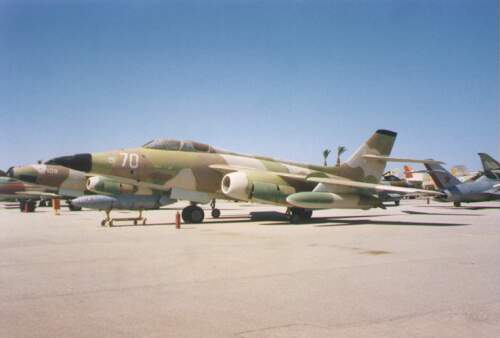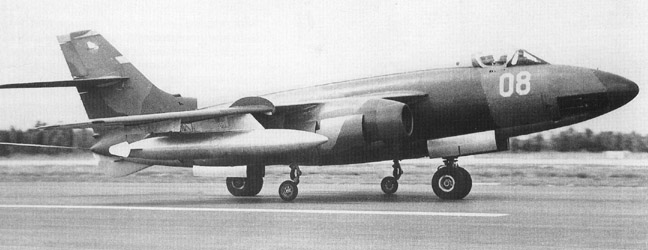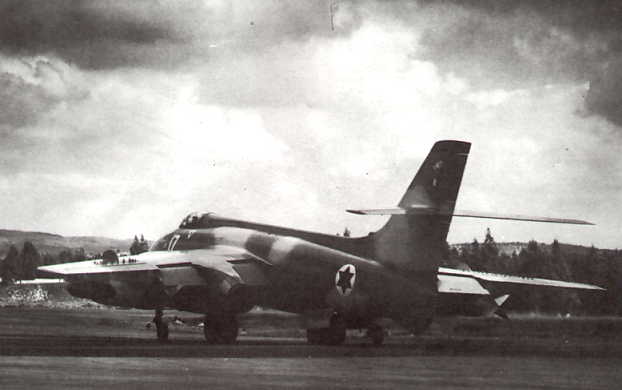
In 1951 Sud-Ouest flew its S.O. 4000 experimental bomber and the trials were so promising that the type was rapidly developed as the S.O. 4050 multi-role combat aircraft. Three variants of the Vautour were developed :


Sud-Ouest Vautour IIN at the IAF Museum, click to enlarge
Shortly after the delieveries of the Vautour had been completed in 1958 the Vautour squadrons settled into their training regime, as with all Israeli aircraft of the time, often interrupted by live combat action. The first encounter between the IAF and the MiG-19 was on August 16th 1959 when two Vautours engaged 4 Egyptian MiGs on the Israeli-Egyptian border. Despite shots fired on both sides, no aircraft were hit. Throughout the 1960s Israel was engaged with Syria in what had become known as the "War for the Water", a series of engagements aimed to foil Syrian attempts to divert Israel's water sources which ultimately led to the Six Days War. As the IAF's primary attack aircraft, Vautours attacked Syrian positions on a number of occasions. On March 16th 1962 three Vautours attacked artillery positions on the Golan Heights and on March 20th a single Vautour chased an Ilyushin Il-28 all the way to Damascus before being ordered to turn back. In the biggest IAF operation since the 1956 operation "Kadesh", November 13th 1964 saw five Vautours taking part in attacks against the entire Syrian array on the Golan. One was hit by anti aircraft fire but managed to complete its mission and return safely to base. More attacks took place on May 13th, July 13th, July 14th and August 15th 1966.
On the morning of June 5th 1967 two electronic warfare Vautour IINs from Ramat David AFB arrived at their stations, one near the Israeli-Egyptian border and the other off the Egyptian coast. Once both aircraft were in position they switched on their jamming pods, disabling Egyptian air defences and opening the way for the dozens of Israeli aircraft that were making their way in complete radio silence to strike at Egypt's air bases. Only the "Knights of the Heart" squadron at Ramat David operated the Vautour at the outbreak of the Six Days War, and it relocatted its 19 aircraft to Tel-Nof shortly before the outbreak of hostilities in order to be closer to the battlefield. During operation "Moked" the Vautours played an important part in the strikes against Egypt's, Jordan's, Syria's and Iraq's air bases, attacking the farthest and most heavily defended, those which were home to Egypt's heavy bombers, the Tupolev Tu-16. Bases attacked included Ras-Banas, Abu-Sweir, Bnei-Swif, Luxor and Cairo West, bases where the heavy bombers were based or had attempted to escape to. Over Abu-Sweir 4 Vautours encountered 4 MiG-21s. One aircraft was shot down but another pair managed to complete their mission unhampered, the third Vautour keeping the MiGs busy until IAF Mirages arrived to give assistance. The Mirages downed three of the MiGs allowing the third Vautour to complete its mission as well. By noon of June 5th,the Egyptian heavy bombers force had been destoryed (8 Tu-16s and 8 Antonov An-12s at Luxor alone) and the Vautours could be allocated to other efforts - The attacks against Jordan, Syria and Iraq during operation "Moked"'s later phases and against Arab ground forces as well.

On the afternoon of June 5th a trio of IAF Vautours attacked Iraq's H3 air base, the Iraqi air force's closest base to Israel as well as a refuge for Jordanian aircraft which had escaped the earlier devastation of their air force. 6 MiG-21s, 3 Hawker Hunters and a transport aircraft were destroyed while evading a pair of Iraqi MiG-21s. On June 6th 4 more Vautours, accompanied by a Mirage pair, returned to H3 after more MiG-21s were reported to have arrived there. a MiG and 2 Hunters were shot down, one Hunter by a Vautour, while 5 more Iraqi aircraft were destroyed on the ground. A third attack was staged on June 7th after Iraqi activity against Israel was stepped up. 4 Vautours and 4 Mirages once more headed for the distant air base and in the IAF's most disastrous operation of the war, 2 Vautours and a Mirage were shot down. An Iraqi MiG-21 and 2 Hawker Hunters were downed as well .
Much like the rest of the IAF, the majority of Vautour sorties following operation "Moked" were flown in assistance of Israel's ground forces on the various fronts. On the evening of June 5th, besides continued strikes against whatever remained of the Arab air forces, Vautours attacked Jordanian armour on its way to
Jerusalem and Jordanian artillery shelling central Israel. On June 6th the Vautours were tasked with the
destruction of Egyptian SA-2s, once again employing the electronic warfare Vautour IINs. Other strikes were also flown against Egyptian armour in the Sinai. During the last three days of the fighting the Vautours were turned against the Syrians on the Golan Heights in anticipation of the Israeli airborne assault against the heights.
 8 Vautours were lost during the Six Days War, yet the end of the war did not bring an end to the hostilities between Israel and its neighbors. Although the losses sustained during the war impeded the type's operation, Vautours repeatly participated in attacks against terrorist positions in Jordan and southern
Lebanon as well as against regular Arab forces. On November 7th 1967 8 Vautours attacked Jordanian artillery, while more attacks took place during January 1968. In April 1969 one aircraft was lost during such an attack. In late July 1969 Vautours participated in attacks on Egyptian forces on the Suez Canal
while Syrian artillery was attacked during August. The Vautours also continued to play their reconnaissance and electronic warfare roles, on December 1st 1967 Vautour no. 30 was lost to Egyptian ground fire while on a reconnaissance flight over the Suez Canal.
8 Vautours were lost during the Six Days War, yet the end of the war did not bring an end to the hostilities between Israel and its neighbors. Although the losses sustained during the war impeded the type's operation, Vautours repeatly participated in attacks against terrorist positions in Jordan and southern
Lebanon as well as against regular Arab forces. On November 7th 1967 8 Vautours attacked Jordanian artillery, while more attacks took place during January 1968. In April 1969 one aircraft was lost during such an attack. In late July 1969 Vautours participated in attacks on Egyptian forces on the Suez Canal
while Syrian artillery was attacked during August. The Vautours also continued to play their reconnaissance and electronic warfare roles, on December 1st 1967 Vautour no. 30 was lost to Egyptian ground fire while on a reconnaissance flight over the Suez Canal.
The new fighters supplied to Israel in the late 1960s by the U.S.A had rendered the Vautours obsolete. A-4 Skyhawks and F-4 Phantoms replaced the Vautours in all their roles including photo-reconnaissance and electronic warfare and in early 1972 the type was retired, the "Knights of the Heart" squadron re-equipping with Skyhawks.
 back to the IDF/AF page
back to the IDF/AF page